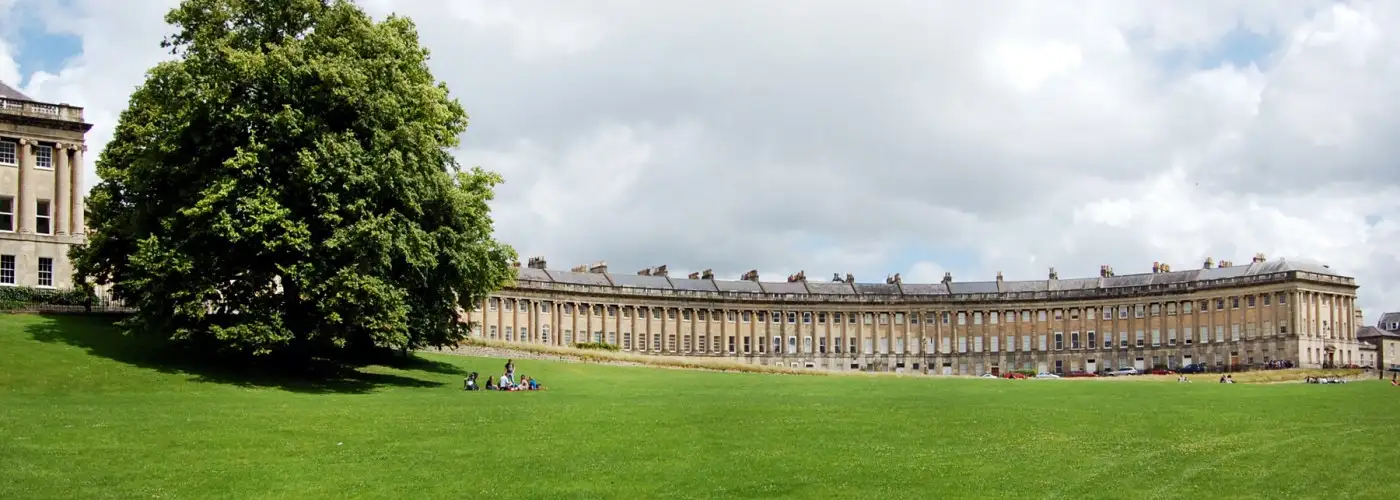Two hundred and fifty years ago, Bath was the Hollywood of Britain. Today, this former trendsetter of Georgian England invites you to take a 90-minute train ride from London and sample its aristocratic charms.
The entire city, built of the creamy limestone called Bath stone, beams in its cover-girl complexion. Proud locals remind visitors that the town is routinely banned from the Britain in Bloom contest to give other towns a chance to win.
Tourists have been enjoying Bath for thousands of years. When the Romans came to Britain in the first century CE, they discovered Bath’s hot springs and promptly built a resort around them. They enjoyed the popular spa for about four centuries before withdrawing from Britain when Rome fell.
The town’s importance carried into the Middle Ages, when Bath was considered the religious capital of Britain. In 973, King Edgar—called the first king of England—was crowned here. Later, Bath prospered as a wool town. With the money it made from wool, Bath built its grand abbey, the last great medieval church erected in England. And sometime in the 1300s, a new thermal bath was built (the original baths had long since deteriorated).
But Bath’s heyday passed, and by the middle of the 1600s, it was just a huddle of huts at the base of the abbey. Then, in 1687, Queen Mary, struggling with infertility, came here and bathed. Within about 10 months she gave birth to a son. A few years later, Queen Anne found that the mineral-laden water eased her painful gout. Word of Bath’s wonder waters spread, and the town earned its way back on the aristocratic map.
The revitalized spa town prospered, and most of the buildings you see today are from the 18th century—the Georgian era (named for the four Georges who sat as England’s kings from 1714 to 1830). In a round-robin of inspiration, the local builders followed the lead of Italian architect Andrea Palladio, who himself made a business of studying Roman ruins. The town bloomed in Neoclassical splendor, with buildings as competitively elegant as the society they once housed.
To imagine you’re one of Bath’s upper crust, cruise along the Royal Crescent. This long, graceful arc of buildings evokes the wealth and gentility of Bath’s glory days. Streets were built not with scrawny sidewalks but with broad “parades,” upon which gentlemen in cutaway coats would stroll and women in stylishly wide dresses could spread their fashionable tails.
To get behind one of those classy facades, drop by the Georgian House at No. 1 Royal Crescent. At this museum, you’ll get an intimate peek into the lavish lifestyles of the age—including how high-class women shaved their eyebrows and pasted on carefully trimmed strips of furry mouse skin in their place. The kitchen has all the latest Georgian gizmos, included a meat spit that was powered—I kid you not—by a dog (he worked in two-hour shifts).
For a real taste of aristocracy, enjoy tea and scones with live classical music in the Pump Room, an elegant Georgian hall just above the Roman baths. It’s your best chance to raise a pinky in Chippendale grandeur. While you’re at it, have a sip of the curative Bath water, pumped up from below to an elegant fountain.
Even better, visit the fine museum that surrounds the ancient baths. At the heart of the site is the ancient spring . That hot thermal water still bubbles, as it has for thousands of years, emerging from the earth at a constant 115 degrees Fahrenheit. At the Great Bath, the centerpiece of the complex, you can almost imagine those Romans lounging around, sipping wine and schmoozing, under the watchful eye of Minerva, goddess of the hot springs.
Bath’s relaxation theme survives to this day. You can dip into the warm thermal waters yourself at a state-of-the-art spa open to the public (for a fee). Go at twilight and settle into the open-air rooftop pool with views over town. If you forgot your swimsuit, check out the Parade Gardens, where a modest admission fee entitles you to a rented lounge chair. Either venue is a perfect chance to see how slow you can get your pulse.
Bath expertly entertains its many visitors with free town walks led by the Mayor’s Corps of Honorary Guides. These well-versed volunteers bring Bath’s amazing Georgian heritage to life in chatty, historical walks. How else would you learn that the old “chair ho” call for your sedan chair evolved into today’s “cheerio” farewell?
If ever a town enjoyed looking in the mirror, Bath’s the one. Good-looking towns are not rare, but few combine beauty and hospitality as well as Bath.
(Photo: Rick Steves)
Rick Steves (www.ricksteves.com) writes European travel guidebooks and hosts travel shows on public television and public radio. Email him at rick@ricksteves.com and follow his blog on Facebook.
You Might Also Like:
We hand-pick everything we recommend and select items through testing and reviews. Some products are sent to us free of charge with no incentive to offer a favorable review. We offer our unbiased opinions and do not accept compensation to review products. All items are in stock and prices are accurate at the time of publication. If you buy something through our links, we may earn a commission.
Top Fares From
Today's Top Travel Deals
Brought to you by ShermansTravel
France: 8-Night Paris, Avignon & Nice...
Infinity Worldwide Vacations
 vacation
$2880+
vacation
$2880+
Poconos: 3 Nts in Garden of...
ResortsAndLodges.com
 hotel
$305+
hotel
$305+
7-Nt Canada & New England Cruise,...
Princess Cruises
 cruise
$839+
cruise
$839+




